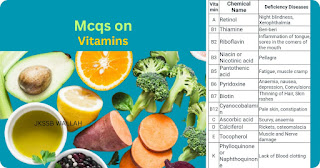1) Which of the following is the scientific name of Vitamin K?
A) Ascorbic acid
B) Phytonadione
C) Tocopherol
D) Pantothenic Acid
Explanation:
Vitamin K is a fat soluble vitamin that help in blood clotting, bone metabolism and calcium regulation.The chemical name of Vitamin K is Phytonadione and its chemical formula is C31H46O2.
2).Which of the following vitamins is also known as cobalamin?
A) B6
B) B2
C) B11
D) B12
Explanation:
Vitamin B-12 plays an important role in formation of RBCs,Cell metabolism,DNA production.As the vitamin B-12 contains a mineral cobalt as it is known as cobalamin.
3).Which of the following nutrient deficiency causes megaloblastic anaemia?
A)Pyridoxine
B)Folic acid
C)Cobalamin
D)Niacin
Explanation:
Megaloblastic anemia is characterised by large size of RBCs.There are two main reason for this type of anemia one is deficiency of Vitamin B-12 and other is folate.The megaloblastic anemia by the deficiency of Vitamin B-12 is known as pernicious anemia.The Folate which is essential for development of RBCs if its deficiency exist in the body may lead to megaloblastic anemia.
4).Which of the following is a water-soluble vitamin?
A) Vitamin B1
B) Vitamin C
C) Vitamin B2
D) All of the above
Explanation:
On the basis of solubility, vitamins are classified into two types: water-soluble vitamins and fat-soluble vitamins.
Water soluble vitamins are those which are dissolved in water and are not stored in the body.They are excreted out from the body with urine if their quantity is more than limit.Vitamin C and Vitamin B complex are the examples of Water-soluble vitamins.
On the other hand fat soluble vitamins are those which are dissolved in fats or oils.They are stored in the body fatty tissue and liver and used when required.The Vitamin A,D,E and K are the example of fat-soluble vitamins.
5). Which among following vitamin functions as both, hormone and visual pigment?
A) Folic Acid
B) Retinol
C) Thiamine
D) Riboflavin
Explanation:
Retinol(Vitamin A) is essential vitamin for various physiological functions, including vision and hormone-related processes.Retinol plays an important role in hormone related processes in the body whereas the pigment function of retinol is that it is a key element in the formation of rhodopsin pigment.This pigment is important for capturing light in the eye and help in visual signaling process.
6). Which of the following is the chemical name of Vitamin A
A) Calciferol
B) Thiamine
C) Retinol
D) Biotin
Explanation:
Vitamin A is a fat soluble vitamin mainly found in fruits, vegetables(carrot),Milk products and Fish.Chemical name of this vitamin is Retinol and Its chemical formula is C20H30O.Deficiency of vitamin A leads to Nightblindness,Xerophthalmia,Skin problems,weak immume system etc.
| Vitamin | Chemical Name | Deficiency Diseases |
| A | Retinol | Night blindness, Xerophthalmia |
| B1 | Thiamine | Beri-beri |
| B2 | Riboflavin | Inflammation of tongue, sores in the corners of the mouth |
| B3 | Niacin or Nicotinic acid | Pellagra |
| B5 | Pantothenic acid | Fatigue, muscle cramp |
| B6 | Pyridoxine | Anaemia, nausea, depression, Convulsions |
| B7 | Biotin | Thinning of Hair, Skin rashes |
| B12 | Cyanocobalamin | Pale skin, constipation |
| C | Ascorbic acid | Scurvy, anaemia |
| D | Calciferol | Rickets, osteomalacia |
| E | Tocopherol | Muscle and Nerve damage |
| K | Phylloquinone or Naphthoquinone | Lack of Blood clotting |
7). Which of the following vitamin deficiency leads to Beriberi?
A) vitamin B1
B) vitamin B2
C) vitamin B7
D) vitamin B9
Explanation:
Beri Beri is a vitamin deficiency disease caused when there is deficiency of thiamine(vitamin B1) in the body.Beri-Beri is common among people who mostly eat polished rice as there is outer layer absent in polished rice.
8) Which of the following vitamins serves as a hormone precursor?
A) Vitamin A
B) Vitamin B
C) Vitamin C
D) Vitamin D
Explanation:
vitamin D is the only vitamin which is synthesized in our own body by a reaction involving sunlight.This vitamin involved in the synthesis of an active hormone known as calcitroil.The hormone calcitroil helps in controlling calcium and phosphorous level in the body.
9). Which of the following diseases is
caused by the deficiency of Niacin?
A) Rickets
B) Beri-Beri
C) Pellagra
D) Scurvy
Explanation:
Niacin or Vitamin B3 is an essential vitamin which is required for energy production,cellular communication,nervous system functioning,DNA repairing in our body.The deficiency of this vitamin leads to disease called pellagra in the body.Pellagra also cause due to deficiency of essential amino acid known as tryptophan which gets converted into Niacin. Food like meat, Legumes,sea food, whole grains,dairy products etc. are good source of vitamin B3.
10). Which vitamin is also known as anti-sterility vitamin?
A) Vitamin A
B) Vitamin B
C) Vitamin D
D) Vitamin E
Explanation:
Vitamin E is important in promoting fertility and reproductive health that is why it is known as anti-sterility vitamin.Due to its antioxidant properties it improves the sperm quality and motility in males and in females this vitamin helps in maintaining uterus health and healthy pregnancy. Some sources of vitamin E are Nuts and seeds, spinach, Brocolli, sunflower oil etc.
11). What is the common name of “Cholecalciferol”?
A) Vitamin A
B) Vitamin B
C) Vitamin C
D) Vitamin D
Explanation:
Vitamin D sometimes also referred as Cholecalciferol because it is derived from cholesterol. Cholecalciferol is the precursor of vitamin D3 .The cholesterol in the body when exposed to sunlight it results in the formation of Cholecalciferol.
Once this Cholecalciferol is formed in the body then it is converted into active form of vitamin D called Calcitriol.
Calcitriol helps in regulating calcium and phosphorus level in the body.
12). Vitamin K deficiency in our body leads to which condition
A) Night Blindness
B) colour Blindness
C) Delay in blood clotting
D) Large size RBCs
Explanation:
Vitamin K is an important vitamin that helps in the clotting of blood.There are certain clotting factor like factor II (prothrombin),VII,IX,X. Vitamin K plays an important role in the formation of these clotting factor in the liver. In the absence of these clotting factor there is delay in blood clotting and which leads to excessive blood loss from the body during an injury. However excessive intake of this vitamin also lead to abnormalities in blood clotting.
13). How many vitamin are there in vitamin B complex
A) 7
B) 8
C) 9
D) 10
Explanation:
Vitamin B complex is a group of eight water soluble vitamins which are important for overall metabolism of our body.The vitamins which are common in this complex are
- Vitamin B1(Thiamine)
- Vitamin B2 (Riboflavin)
- Vitamin B3 (Niacin)
- Vitamin B5 (Pantothenic acid)
- Vitamin B6 (Pyridoxine)
- Vitamin B7 (Biotin)
- Vitamin B9 (Folate or Folic Acid)
- Vitamin B12 (Cobalamin).
14). Scurvy is due to deficiency of which vitamin
A) Vitamin A
B) Vitamin B
C) Vitamin C
D) Vitamin D
Explanation:
Scurvy is caused due to deficiency of Vitamin c ( Ascorbic acid).
Functions of vitamin C
Vitamin c is essential for the formation of collagen fiber in the body
Wound healing in the body
Iron absorption
Maintaining immune health
Disease due to deficiency of Vitamin C
weakness, fatigue, swollen and bleeding gums, joint pain, poor wound healing, and skin discoloration.
Sources of Vitamin C
citrus fruits (such as oranges and lemons), berries, kiwi, broccoli, tomatoes, peppers, and leafy green vegetables.
15). Which among the following pair is water soluble vitamin
A) Vitamin A and B
B) Vitamin B and C
C) Vitamin C and D
D) Vitamin K and E
Explanation:
Vitamins are classified into two categories on the basis of how they dissolves. water soluble vitamins are not stored in the body whereas fat soluble vitamins are stored in the body.
| Fat-soluble vitamins | Water-soluble vitamins |
|---|---|
| Vitamin A | Vitamin B complex |
| Vitamin D | Vitamin C |
| Vitamin E | |
| Vitamin K |
16). Niacin can be derived in human beings from which amino acid
A) Glutamic Acid
B) Tryptophan
C) Lysine
D) Arginine
Explanation:
In Human beings Niacin is being derived from amino acid tryptophan.This conversion is through a pathway known as kynurenine pathway.Tryptophan is an essential amino acid found in many dietary sources such as meat, poultry, fish, eggs, and dairy products.
17). Deficiency of Vitamin A causes
A) Xeropthalmia
B) Creatinuria
C) Pellagra
D) Hypoprothrombinemia
Explanation:
Xeropthalmia is a condition in which there is dryness in the cornea due to deficiency of Vitamin A.Vitamin A plays a crucial role in maintaining the health of the eyes, and its deficiency can lead to various eye problems, including night blindness, dryness, and eventually xerophthalmia.
18). Which of the following nutrient is essential during the early stages of pregnancy?
A) Thiamine
B) Riboflavin
C) Niacin
D) Folic acid
Explanation:
Folic acid( vitamin B9) is the vitamin which is essential during the pregnancy.Folic acid is a B-vitamin that plays a vital role in the early development of the neural tube in the fetus, which eventually forms the baby’s brain and spinal cord.
19). Which of the following food sources has the highest levels of ascorbic acid?
A) Black Currant
B) Sweet Potato
C) Fish oil
D) Lemon
Explanation:
Black currant is a type of berry which when ripened is black in colour. It is highly rich in Vitamin C (Ascorbic acid). Vitamin c is an antioxidant and helps in strengthening immune system, cardiovascular health,skin health.
20). Which vitamin is essential for healthy brain
A) Vitamin B6
B) Vitamin B9
C) Vitamin B12
D) All of the above
Explanation:
Vitamin B6 is involved in the synthesis of neurotransmitters such as serotonin, dopamine, and gamma-aminobutyric acid (GABA)
Vitamin B9 helps in the Methylation reactions,Neurogenesis,prevent neural tube defects in the developing foetus.
Vitamin B12 is also a essential vitamin for brain health.
21). Which of the following vitamins is synthesized in the body by intestinal bacteria?
A) Vitamin A
B) Vitamin D
C) Vitamin E
D) Vitamin K
Explanation:
Vitamin K is the vitamin that is synthesized in the body by intestinal bacteria. The synthesis occurs in the large intestine, where certain bacteria produce a form of vitamin K called menaquinones or vitamin K2.
22). Vitamins often acts as
A)Holoenzymes
B) Apoenzymes
C) Co-enzyme
D) co-factor
Explanation:
Coenzymes are small molecules that assist enzymes in carrying out various biochemical reactions in the body.some common vitamins which act as coenzyme are Vitamin B1,B2,B3,B5 and B6.
23). Rickets is caused due to the deficiency of________
A) Vitamin A
B) Vitamin B
C) Vitamin C
D) Vitamin D
Explanation:
Vitamin D plays a crucial role in the absorption of calcium and phosphate from the diet and their utilization in bone mineralization.So the deficiency of vitamin D leads to bone pain, muscle weakness, delayed growth, bowed legs, dental problems, and skeletal deformities.
24). Which organ stores fat-soluble vitamins?
A) Kidneys
B) Liver
C) Stomach
D) Spleen
Explanation:
The fat soluble vitamins are stored in the liver.The main fat soluble vitamins are vitamin A,D,E and K.These vitamins are stored in the hepatocytes of liver and used when required.
25). Vitamin E prevents
A) Formation of Vitamin D in Skin
B) Secretion of Superfluous enzymes
C) Absorption of harmful enzymes
D. Keratinisation of epidermal cells
Explanation:
Keratinization is a natural process in which the outermost layer of the skin, called the stratum corneum, becomes toughened and provides a protective barrier.Vitamin E helps prevent the keratinization of epidermal cells.This is because vitamin E is a potent antioxidant that helps protect the cell membranes

